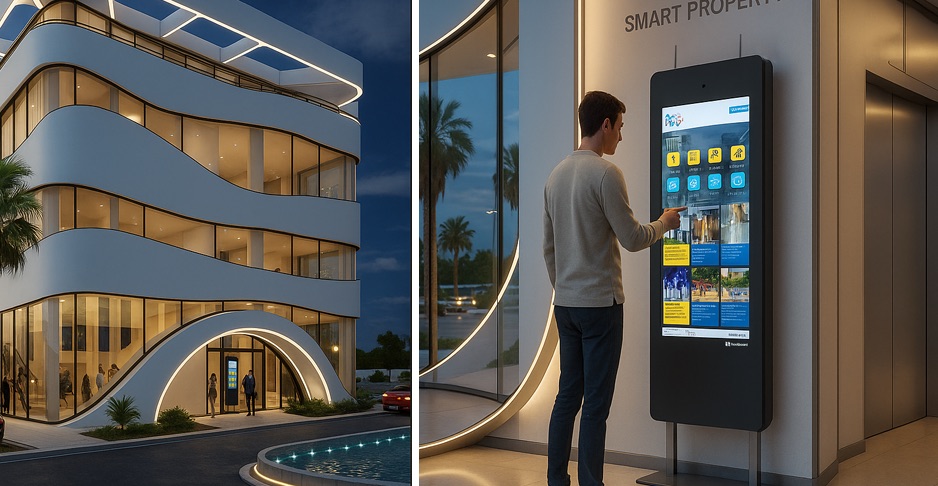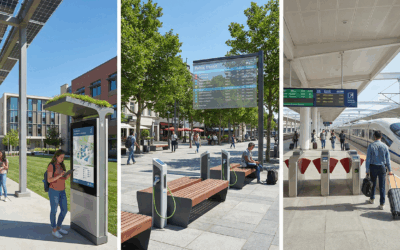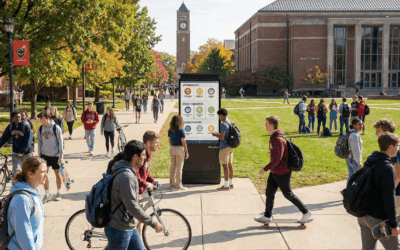Real estate is not just about square footage anymore. It’s about experience. In an age where digital convenience defines every aspect of our lives—from banking and healthcare to shopping and travel—real estate is undergoing a necessary transformation.
Tenants no longer evaluate a building purely by its façade or price per square foot. They consider how “smart” the property is: how easy it is to navigate, how connected the amenities are, how responsive the management is, and how engaging the environment feels.
Interactive kiosks are emerging as one of the simplest yet most powerful tools to help real estate stakeholders bridge the gap between physical infrastructure and digital expectations. They serve as intuitive, accessible, always-on digital interfaces that enhance property value, improve tenant satisfaction, and unlock data-driven insights for better asset management.
This article dives into why interactive kiosks are becoming a standard feature in smart real estate development, how they directly contribute to tenant engagement and leasing potential, and why forward-thinking REITs and property managers are making them a core part of their strategy.
Why Smart Real Estate Is Now the Industry Norm
Before diving into kiosks specifically, it’s important to understand the broader trend shaping the built environment: smart real estate.
A smart building integrates technology systems—such as IoT sensors, access control, energy management, tenant communication tools, and data analytics—to provide a more efficient and responsive environment.
According to MarketsandMarkets, the global smart building market is projected to grow from $96 billion in 2023 to $229 billion by 2028, growing at a CAGR of 18.2%. This growth is being driven by a combination of tenant demand, operational efficiency, and ESG (Environmental, Social, Governance) goals.
Key components of smart buildings include:
- Touchless access and security systems
- Energy efficiency and environmental monitoring
- Predictive maintenance systems
- Tenant experience platforms
- Digital signage and kiosks for communication and interaction
In this landscape, interactive kiosks serve as both a front-end interface for users and a data collection tool for building operators—making them an essential touchpoint in smart infrastructure.
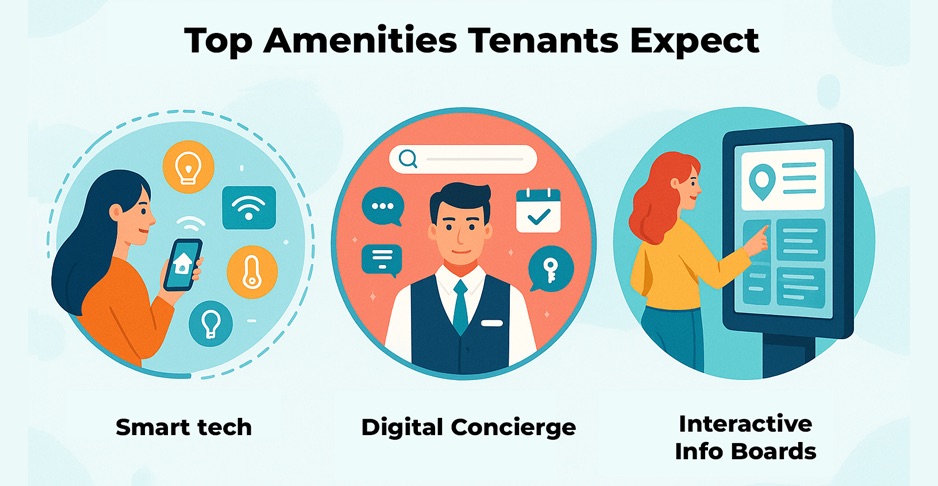
The Shift in Tenant Expectations
Millennials and Gen Z now constitute the majority of renters in urban areas, and their expectations are vastly different from prior generations. They want everything digital, instant, and personalized.
- A Deloitte survey found that 67% of millennial renters say smart technology is a deciding factor in their leasing decision.
- Another report by NMHC/Kingsley Associates revealed that tenants are 31% more likely to renew a lease if the property offers smart amenities that improve convenience.
These tenants expect:
- Seamless access to building information
- Instant responses to queries or maintenance issues
- Real-time updates on community news
- Smart concierge services
This is where interactive kiosks come in—not just as information stations, but as engagement tools that give tenants control over their environment while reducing the communication load on property staff.
What Makes Interactive Kiosks So Valuable?
Interactive kiosks are not new. But the way they’re being deployed in modern real estate is evolving rapidly. They now act as integrated service hubs that connect tenants, visitors, and staff in real time.
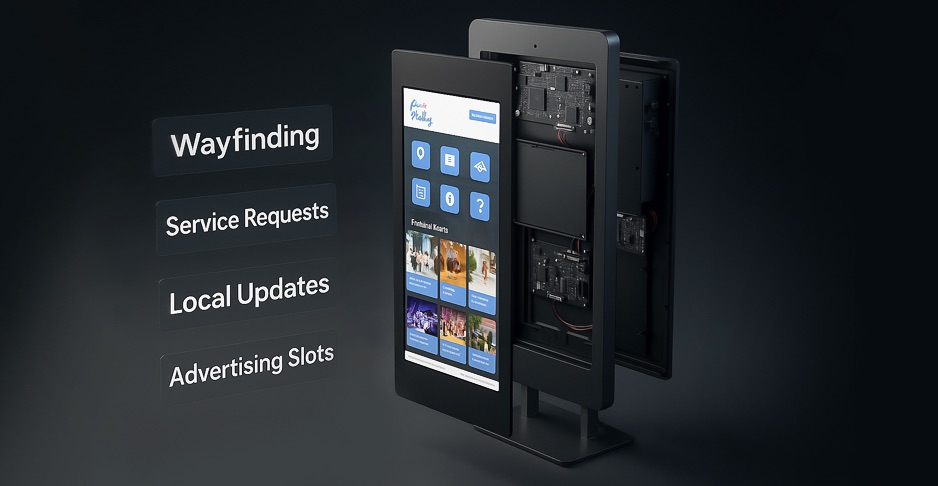
Here’s what today’s kiosks can offer:
1. Centralized Information Hub
From building directories to upcoming events, interactive kiosks provide a centralized point for information. This ensures that:
- Tenants always know what’s happening
- Visitors can easily find their way around
- Staff don’t have to repeat information throughout the day
2. Leasing and Availability Portals
A major innovation is the integration of leasing functions into kiosk interfaces. Prospective tenants can:
- Browse available units
- Schedule tours
- View virtual walkthroughs
- Apply directly from the kiosk
This streamlines the leasing process, especially in large multi-unit developments where leasing offices may not be open 24/7.
3. Community Engagement
Kiosks can showcase community events, promotions, and announcements in a visually compelling way. This enhances the sense of community within residential complexes and increases participation in amenities and programs.
4. Smart Integration
Modern kiosks can be linked with:
- Access control systems (for building entry or room bookings)
- Maintenance ticketing platforms
- Energy management dashboards
- Emergency alert systems
This makes the kiosk a critical node in the smart building ecosystem.
Operational Efficiency and Cost Reduction
One of the often-overlooked benefits of kiosks is how they improve operational efficiency.
In traditional buildings, front desk staff or leasing agents spend a significant portion of their time answering routine questions—What’s the Wi-Fi password? How do I reserve the rooftop space? When is the next fire drill?
Kiosks handle these queries effortlessly.
According to data from a multi-property case study by CBRE, implementing digital self-service kiosks led to:
- 24% reduction in front desk staffing hours
- 38% drop in repetitive support tickets
- 20% increase in positive tenant feedback scores
These aren’t just soft wins—they directly impact OPEX and tenant retention, two of the most critical levers in real estate asset management.
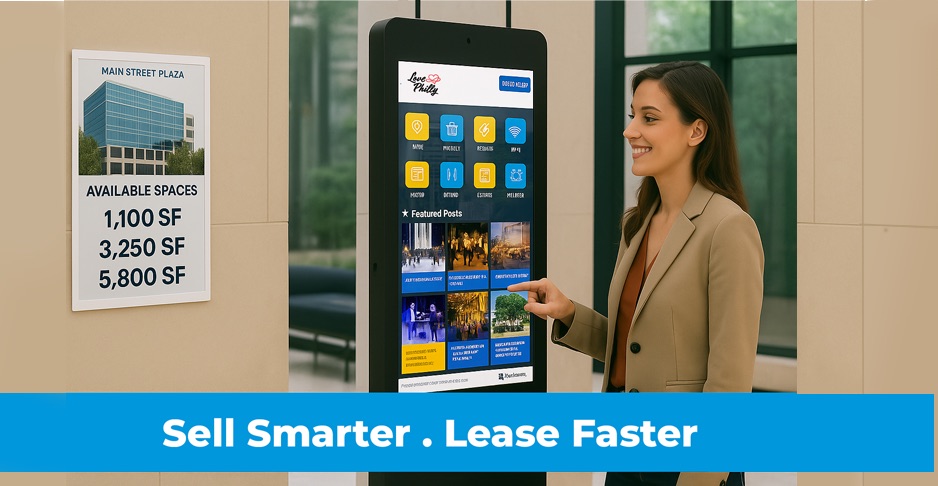
Real Estate as an Experience: From Static to Interactive
Traditionally, real estate has been a static industry. Once a building is constructed and leased, changes are minimal. But the digital age is shifting this mindset. Now, buildings are expected to respond and adapt—just like the apps on your phone.
Kiosks help make this possible by acting as real-time communication and feedback channels.
Examples:
- In an office park, tenants can use kiosks to report issues with conference rooms or HVAC.
- In residential buildings, residents can book amenities or leave feedback on events.
- In mixed-use retail spaces, kiosks can promote special offers from on-site vendors or restaurants.
In every case, the building becomes interactive—and this interaction drives higher satisfaction, longer leases, and greater loyalty.
Data: The Hidden Goldmine
Kiosks don’t just serve users—they generate data. Every interaction logged through a kiosk gives property managers valuable insights:
- What are tenants searching for most?
- Which amenities are underutilized?
- What times of day see the most kiosk activity?
- Which announcements receive the most engagement?
This data can inform:
- Leasing and pricing strategies
- Amenity investments
- Staffing schedules
- Content optimization
A property that listens to its users via kiosk data can evolve faster, respond to issues quicker, and provide more targeted value—becoming a truly adaptive environment.
Kiosks as Revenue Engines
Forward-looking property owners are also exploring monetization through kiosks. These include:
- Promoting local businesses via paid ads
- Highlighting premium amenities or services
- Offering booking options for external vendors (e.g., dog walkers, dry cleaners)
In high-traffic properties, a kiosk network can become a micro advertising platform that generates passive revenue without detracting from tenant experience.
Strategic Considerations for Developers and REITs
For developers, kiosks offer early-stage differentiation. Including them in the pre-leasing phase signals a commitment to smart design and tenant experience.
For REITs, the value is both operational and financial:
- Better tenant retention = Lower churn = Higher NOI
- More data = Better asset decisions = Stronger portfolio performance
- Enhanced ESG narrative = More investor confidence
Building for the Future
Interactive kiosks are not just a trend. They are the new interface between properties and people. As real estate becomes more service-oriented, these kiosks represent a flexible, scalable, and impactful way to enhance tenant experience, streamline operations, and unlock new value.
Smart buildings are the future. And smart buildings start with smart touchpoints.

